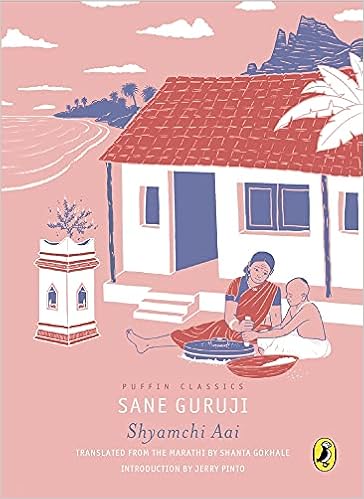
Sukhada Tatke is a reporter and writer on topics related to culture, gender, immigration, books, etc. Click through for the full bio and contributions.
Shyamchi Aai by Sane Guruji (Sadashiv Pandurang Sane); translated by Shanta Gokhale | Puffin Classics by Penguin Random House, India | August 01, 2021
Reviewer: SUKHADA TATKE

When Mahatma Gandhi promised Dr. Babasaheb Ambedkar that he would work to end untouchability, another man in Maharashtra (known then as the Bombay Presidency) took it upon himself to do what he could in his capacity. Sadashiv Pandurang Sane—or Sane Guruji, as he was fondly known—traveled the length and breadth of the region to raise awareness of the issue. In May 1947, the freedom fighter and social reformer, who had come of age during the British Raj, fasted for eleven days in Pandharpur, urging the authorities of the famous Vitthal temple to open their gates to untouchables. Two months after Independence, they were given entry.
Growing up in Maharashtra, you would have heard this story recounted on multiple occasions. When you read Shyamchi Aai, Sane Guruji’s most famous book, you find clues about some of what may have contributed to a Brahmin man from the Konkan becoming one of the loudest critics of the caste system.
Take this anecdote, for instance. When he was a young boy, his mother told him something that would shock him but also reaffirm his visceral love and compassion toward all living beings. A Mahar woman was resting outside the Sanes’ house, we learn, too tired to gather the firewood that had fallen from her head. His mother asked Shyam—his childhood name—to help her. As a Brahmin, living in a Brahmin neighborhood, Shyam wondered about the repercussions. His mother assured him that she would bathe him once he was done but “only because we still have to live in this society and don’t have the courage to face its censure, not because they [the untouchables] are sinners or their touch is polluting.” A young Shyam also delivered a monologue on the corrupting influence of money and power on human beings, and their concomitant hypocrisy: “They wear animal hides on their feet . . . Those slippers don’t pollute them. But the man who has made those very slippers is supposed to pollute them.”
Sane Guruji wrote Shyamchi Aai in Marathi from a Nashik jail, where he was imprisoned for two years from 1933 to 1935 for his participation in India’s freedom struggle. The book, first published in 1935 (some of the stories had already appeared in a children’s magazine), is an autobiographical account of his childhood. The latest edition, published in 2016, is a testament to its popularity. Shanta Gokhale’s superb new translation for Penguin’s Puffin Classics imprint has given this Marathi classic a new audience.

Replete with quiet homespun wisdom for adults and children alike, aphorisms and everyday observations, these stories, or episodes, narrated over forty-two nights by an adult Shyam to kids in a fictitious ashram, are a homage to his mother, Yashoda. “Not a day went by,” Sane Guruji writes, “when he did not thank her silently for [being wonderful], sometimes shedding tears of gratitude.”
When one begins reading, one fears it might be a saccharine and sentimental account of a man devoted to his perfect mother. Often, it is indeed that. But one sees quickly that, even as he worships her, he presents a complex and complete portrait of his mother as an uneducated and astonishingly worldly and sharp-tongued woman, married into a well-off family that gradually slides into the depths of poverty; well-rooted in traditions and religious rituals, yet fiercely independent and progressive. She is given equally to red bursts of temper and to smooth ripples of tenderness. By example, she transmits into Shyam the importance of maintaining dignity and self-respect even in the most dire circumstances.
The book is also a unique glimpse into life in the Konkan, an area along Maharashtra’s coast. Here you see “rivers of rainwater gurgling down the slopes,” trenches that channelize water from a great distance, all manner of fruits and vegetables growing in abundance, and birds, insects and animals coexisting with humans. Anyone who has visited the Konkan can palpably feel the captivating beauty of the region in these pages.
Above all, the narrative bears testimony to Sane Guruji’s priorities and preoccupations as a very young, deeply emotional, and sensitive boy. Some examples, either recounted by himself in the ashram, or produced verbatim as uttered by his mother or father:
- There is “no worse sin than living off another’s labor.”
- “Only a nation that is built on social welfare and social growth, where socially beneficial work is worshipped, will attain glory. The rest will be reduced to beggary.”
- “Sin, like merit, never dies.”
- “It is silly to do things that are beyond your strength, but wicked not to do something that is within your powers out of sheer laziness.”
Sometimes, the portrayals and descriptions in Shyamchi Aai are jarring. Not because the translation is wanting—Gokhale is one of India’s finest translators—but because that world is so distant from the one we inhabit today. Some things make you cringe in 2021: the treatment of women, a willing acceptance of the caste system, a blind adherence at all costs to the voices of the elders. But to read all of this out of the context of its time and place is to do a grave disservice to it as a literary work. Even though much of the conversation between mother and son in this cult classic may seem anachronistic to us now, it holds value as an account of an India on the cusp of Independence. The knowledge of the journeys of our forebears—what they thought, how they spoke, why they did certain things—helps us understand not just our past but also how we got here, today. Even the young Shyam is always seen questioning the status quo, even as his mother teaches him, among other things, not to feel shame for doing a “woman’s job.”
Shyamchi Aai may seem a touch remote from our present vantage point. Yet, the importance and triumph of love as an all-prevailing, universal theme is never obsolete or unrelatable. Even though Shyam’s childhood was steeped in poverty and hardship, he buoyed along, thanks to the cushioning love of his mother, and equally of his father, siblings, and neighbors.
“Flowers bloom only on plants. Put them in water for as long as you like, they will not bloom . . . plants are mothers to their flowers. They nourish them and help them blossom,” Shyam’s mother tells him one day. If you have ever wondered how the great Sane Guruji became the man that he did, look no further than this book. The answer lies, of course, in Shyamchi aai.
Back to #DesiBooksReview Issue 1


Sukhada Tatke is a reporter and writer on topics related to culture, gender, immigration, books, etc. Click through for the full bio and contributions.
